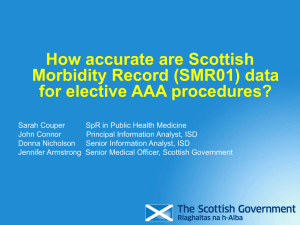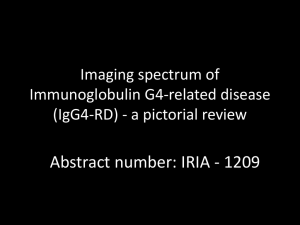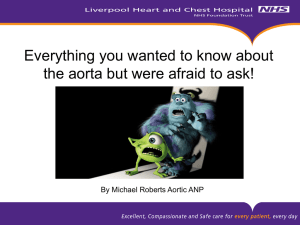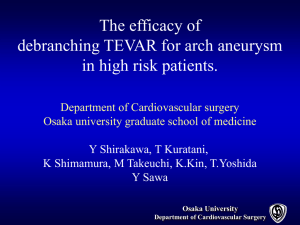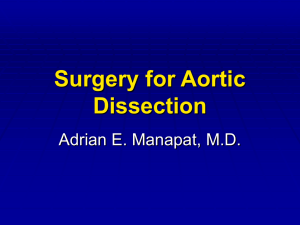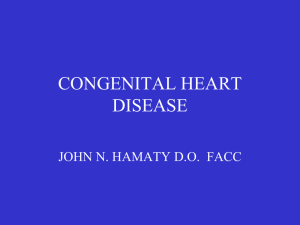View PowerPoint Slides
advertisement
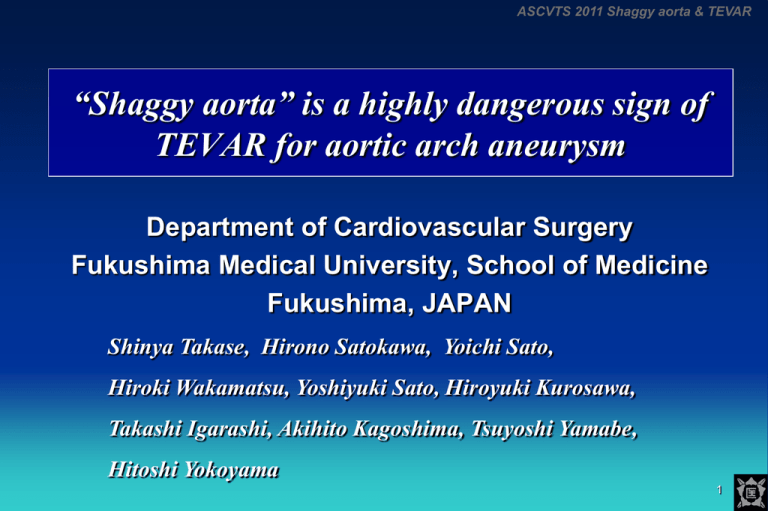
ASCVTS 2011 Shaggy aorta & TEVAR “Shaggy aorta” is a highly dangerous sign of TEVAR for aortic arch aneurysm Department of Cardiovascular Surgery Fukushima Medical University, School of Medicine Fukushima, JAPAN Shinya Takase, Hirono Satokawa, Yoichi Sato, Hiroki Wakamatsu, Yoshiyuki Sato, Hiroyuki Kurosawa, Takashi Igarashi, Akihito Kagoshima, Tsuyoshi Yamabe, Hitoshi Yokoyama 1 ASCVTS 2011 Shaggy aorta & TEVAR Background •Conventional surgery for thoracic aortic aneurysm still has high morbidity and mortality. •In this condition, stentgraft is applied to descending thoracic aortic disease more than graft replacement. •For arch aorta, stentgraft is only deployed to high risk patients in general. However, in TEVAR for this lesion, stroke is concerned because of atheromatous embolization. •Conventional surgery for arch aortic aneurysm even with severe atherom induces catastrophic complication followed by early death. 2 ASCVTS 2011 Shaggy aorta & TEVAR Purpose This paper is to explore whether TEVAR for aortic arch aneurysm with “shaggy aorta” is acceptable or not. 3 ASCVTS 2011 Shaggy aorta & TEVAR Severely atheromatous aorta Definition of “Shaggy aorta” Intimal thickness > 2mm No irregularity IT>2mm + Irregularity but not projected Noraml Intimal thickness(IT) < 2mm No irregularity Irregularity (+) 4 IT>2mm + Irregularity with projection ASCVTS 2011 Shaggy aorta & TEVAR Case 4 77 y.o. male, True aortic arch aneurysm, Angina ASCVTS 2011 Shaggy aorta & TEVAR Case 1;82y.o. female Arch Aneurysm with aberrant artery ASCVTS 2011 Shaggy aorta & TEVAR Treatment Strategy Indication of Conventional Surgery? •Age>75 y.o., •Severity of co-morbidity •Concomittant Procedure (CABG, Valve Surgery)? Possible Impossible Concomittant Proc. Difficult Treans-femoral Access CS Yes No Zone0~1 debranched SG Fenestrated SG Zone2 SG ASCVTS 2011 Shaggy aorta & TEVAR SG deployment •Examination •MD-CT>Angiography •Endoluminal Stentgraft (tailered made) •GiantrucoZ stent ; d30-40X l 50-75mm •UBE Ultrathin graft ; d28-40X l 50-150mm •Delivery system (Pull through) •COOK Guiding Sheath (straight / bending) •0.035” Super stiffness / TERMO J type 230cm •Deployment •Hypotension (60-80mmHg) / ATP 0.2-0.4mg/kg / •Rapid pacing 120-140 ppm •Monitoring •INVOS / MEP ( in some cases) 8 ASCVTS 2011 Shaggy aorta & TEVAR Fenestrated SG for aortic arch aneurysm Max diameter;42mm Saccular type ASCVTS 2011 Shaggy aorta & TEVAR (Debranching) + Transaortic SG 8X16mm Y-graft 3) Reconstruction of cerebral arteries (debraching) 8mm 8mm 5F Pigtail 10mm 1) Branched Graft SG (22F Guiding Sheath) over the wire 2) Side clamping and anastomosis 4) Trans-aortic SG ASCVTS 2011 Shaggy aorta & TEVAR Patients Jan., 2001~May, 2010 SG repair for aortic arch aneurysm (Non-dissecting aneurysm) 23 Cases Male:Female = 19:4, Age ; 74±7 y.o., Observation ; 30~3219 (848±1058) days 11 ASCVTS 2011 Shaggy aorta & TEVAR Patients’ Profile with “Shaggy aorta” or not Shaggy aorta, n(%) Non “Shaggy aorta”, n(%) n=23 n=8 n=15 Male:Female Age HT HL DM 7:1 12:3 75±6 8(100) 6(75) 1(13) 73±7 15(100) 10(67) 0(0) 0.65 0.59 1.00 0.67 0.35 Cerebrovascular diseases Cardiac disorders Respiratory dysfunction Renal insufficiency 2(22) 3(38) 2(50) 2(25) 5(33) 3(20) 3(53) 3(20) 0.12 0.62 1.00 1.00 PAD 4(50) 1(7) 0.033 Multiple aortic aneurysm 2(25) 2(13) 0.59 Logistic EuroSCORE 30.1±24.6 23.1± 20.1 0.76 ASCVTS 2011 Shaggy aorta & TEVAR Postoperative Outcome Shaggy aorta, n=8 Non Shaggy aorta, n=15 Approach from aorta 5(63) 4(27) 0.18 CPB use 1(13) 2(13) 1.00 Debranching 5(63) 7(47) 0.67 SG top;Zone0/1/2/3 3(38)/3(38)/0(0)/2(25) 2(13)/3(20)/5(33)/5(33) 0.19 2(25) 0(0) 1(13) 1(13) 1(13);dissection 2(13) 1(7) 0(0) 2(13) 1(7); aorta rupture* 0.59 1.00 0.35 1.00 1.00 Primary Outcome Endoleak Surgical conversion Additional SG Access trouble Aorta injury 13 ASCVTS 2011 Shaggy aorta & TEVAR Postoperative Outcome 14 Non Shaggy aorta, n=14 Cerebral infarction Respiratory failure Pneumonia Shaggy aorta, n=9 1(13) 3(38) 2(25) 0(0) 2(13) 0(0) 0.35 0.30 0.11 Renal dysfucntion Hemodialysis Bowel ischemia Gastric bleeding 3(38) 3(38) 0(0) 0(0) 1(7) 1(7) 0(0) 1(7) 0.10 0.10 1.00 1.00 Paraparesis 2(25) 0(0) 0.11 Any morbidities 5(63) 2(13) 0.026 MOF 1(13) 0(0) 0.35 Death in 30days 1(13) 1(7) 1.00 Hospital death 4(50) 2(13) 0.13 *MOF;1, Pneumonia;2, AAA rupture;1, ASCVTS 2011 Shaggy aorta & TEVAR Actual Survival 71% 50% Non-shaggy Shaggy Log-rank p=0.13 15 ASCVTS 2011 Shaggy aorta & TEVAR Summary • SG treatment for aortic arch aneurysm is technically successful with debranching and/or fenestrated SG. • There were no differences in preoperative comorbidities between patients group w/ and w/o “shaggy aorta”. • Embolim was induced around 50% in the group with “shaggy aorta”, whereas it was 0% in that without “shaggy aorta”. • As the result, once one or more organ dysfunctions were occurred in such high risk patients, it led to death. • Once the patients with “shaggy aorta” can tolerate this treatment, they could survive in long time period. ASCVTS 2011 Shaggy aorta & TEVAR Conclusion “Shaggy aorta“ is a dangerous sign. Special caution of handling in this procedure is required. Adequate informed consent to such patients is also required. Invention of completely preventive measures against embolism is aspired.

